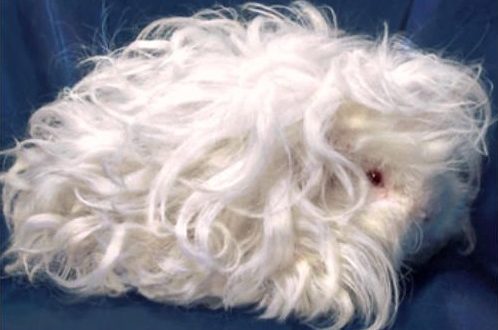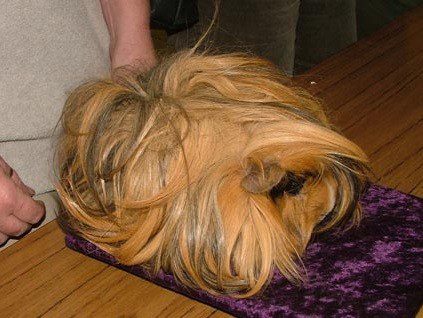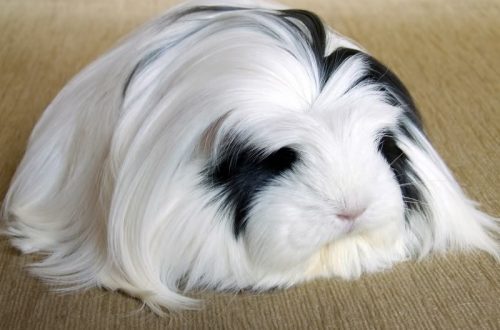
Abyssinian guinea pig
Abyssinian guinea pigs are mobile, cheerful and unpretentious in maintenance – they do not require special hair care. A distinctive feature of the breed is an extraordinary greed for food. Who is the first to “fall out” of the open door of the cage when he smells a cucumber? Of course, the Abyssinian guinea pig! This wonderful quality is very helpful when taming a pig.
For breeders, the breed is of particular interest – after all, it is the most difficult breed to breed. And if the breeder gets offspring of good quality, there really is something to be proud of!
Abyssinian guinea pigs are mobile, cheerful and unpretentious in maintenance – they do not require special hair care. A distinctive feature of the breed is an extraordinary greed for food. Who is the first to “fall out” of the open door of the cage when he smells a cucumber? Of course, the Abyssinian guinea pig! This wonderful quality is very helpful when taming a pig.
For breeders, the breed is of particular interest – after all, it is the most difficult breed to breed. And if the breeder gets offspring of good quality, there really is something to be proud of!

Contents
The main features of the Abyssinian guinea pigs
The most important distinguishing feature by which you can immediately determine the Abyssinian in front of you or not is the so-called rosettes on the wool.
Rosettes are a kind of funnels on wool, when the hairs do not grow evenly as a result of a mutation, but form such an open flower, grow from the center, forming a funnel.
Usually there are 6-10 such rosettes throughout the coat, they are absent only on the stomach and head.
A special form of mutation among the Abyssinians is also interesting – the so-called “double rosettes”. Instead of one rosette, two are formed at once, and the pig turns out to be all in small rosettes. There can be up to 30 of them!
Evenly shaped rosettes with a clear center and no excess hair coming out of it are considered ideal. Moreover, the rosettes should be formed symmetrically: the same number of rosettes on each side of the body. The ideal Abyssinian will have 8-10 rosettes on the right and left shoulder, four or two on the back and one on each side of the thighs. The edges of the outlets should ideally be clear indicators of where each outlet begins and ends.
In fact, pigs with perfect rosettes are not born so often, many Abyssinians have wool and rosettes that are imperfect by show standards. So if you own a cute Abyssinian pig with symmetrical rosettes, it’s likely that you’ll want to show your pet off at a guinea pig show. In recent years, such exhibitions have been held regularly.
But if your funny pet’s fur isn’t quite perfect, don’t be discouraged. All the same, your guinea pig will love you just as much as an Abyssinian with perfect fur.
The most important distinguishing feature by which you can immediately determine the Abyssinian in front of you or not is the so-called rosettes on the wool.
Rosettes are a kind of funnels on wool, when the hairs do not grow evenly as a result of a mutation, but form such an open flower, grow from the center, forming a funnel.
Usually there are 6-10 such rosettes throughout the coat, they are absent only on the stomach and head.
A special form of mutation among the Abyssinians is also interesting – the so-called “double rosettes”. Instead of one rosette, two are formed at once, and the pig turns out to be all in small rosettes. There can be up to 30 of them!
Evenly shaped rosettes with a clear center and no excess hair coming out of it are considered ideal. Moreover, the rosettes should be formed symmetrically: the same number of rosettes on each side of the body. The ideal Abyssinian will have 8-10 rosettes on the right and left shoulder, four or two on the back and one on each side of the thighs. The edges of the outlets should ideally be clear indicators of where each outlet begins and ends.
In fact, pigs with perfect rosettes are not born so often, many Abyssinians have wool and rosettes that are imperfect by show standards. So if you own a cute Abyssinian pig with symmetrical rosettes, it’s likely that you’ll want to show your pet off at a guinea pig show. In recent years, such exhibitions have been held regularly.
But if your funny pet’s fur isn’t quite perfect, don’t be discouraged. All the same, your guinea pig will love you just as much as an Abyssinian with perfect fur.
From the history of Abyssinian guinea pigs
It is likely that this is one of the oldest breeds, and the Abyssinian guinea pig has been around for many centuries.
Today, no one can say for sure why these pigs were called Abyssinian.
Those who are well acquainted with geography and history may assume that the Abyssinian guinea pigs got their name from the place of their homeland, that is, that they come from the historical region of the ancient state of Abyssinia (the territory of modern Ethiopia in Africa). However, it is not. This breed is nowhere to be found in this region (the guinea pigs are native to South America – a different continent altogether!), completely destroying the common misconception that they were found in Abyssinia.
The first Abyssinian was brought from America to Europe in the XNUMXth century. Then these exotic pets were very expensive. For some unknown reason, someone in England decided to name the rosette guinea pigs the Abyssinian, and the breed has retained this name to this day.
It is likely that this is one of the oldest breeds, and the Abyssinian guinea pig has been around for many centuries.
Today, no one can say for sure why these pigs were called Abyssinian.
Those who are well acquainted with geography and history may assume that the Abyssinian guinea pigs got their name from the place of their homeland, that is, that they come from the historical region of the ancient state of Abyssinia (the territory of modern Ethiopia in Africa). However, it is not. This breed is nowhere to be found in this region (the guinea pigs are native to South America – a different continent altogether!), completely destroying the common misconception that they were found in Abyssinia.
The first Abyssinian was brought from America to Europe in the XNUMXth century. Then these exotic pets were very expensive. For some unknown reason, someone in England decided to name the rosette guinea pigs the Abyssinian, and the breed has retained this name to this day.
The nature of the Abyssinian guinea pigs
There is a well-established belief among guinea pig breeders and owners that Abyssinian guinea pigs are more mischievous and active than other breeds. Perhaps the reason lies in their heightened curiosity. Of course, there is no concrete evidence of this fact, no studies have been conducted on the dependence of the character of a guinea pig on its breed, this is just an opinion, and believe it or not, the decision is yours.
And please don’t let this opinion scare you away from getting yourself an Abyssinian guinea pig. Abyssinians are truly magnificent guinea pigs with their own character and personality. Yes, all guinea pigs love the company of people, but this is a special breed. They seem to enjoy being in our company much more than other pigs.
Abyssinians are very energetic and active, especially at a young age. They have a very lively character, and it is quite easy to establish good relations and make friends with them.
It is believed that they lend themselves well to training and education.
There is a well-established belief among guinea pig breeders and owners that Abyssinian guinea pigs are more mischievous and active than other breeds. Perhaps the reason lies in their heightened curiosity. Of course, there is no concrete evidence of this fact, no studies have been conducted on the dependence of the character of a guinea pig on its breed, this is just an opinion, and believe it or not, the decision is yours.
And please don’t let this opinion scare you away from getting yourself an Abyssinian guinea pig. Abyssinians are truly magnificent guinea pigs with their own character and personality. Yes, all guinea pigs love the company of people, but this is a special breed. They seem to enjoy being in our company much more than other pigs.
Abyssinians are very energetic and active, especially at a young age. They have a very lively character, and it is quite easy to establish good relations and make friends with them.
It is believed that they lend themselves well to training and education.
Care and maintenance of the Abyssinian guinea pig
Caring for an Abyssinian guinea pig is not particularly difficult. Abyssinians are slightly more difficult to care for compared to other guinea pig breeds, but much easier compared to other pets.
The main feature is hair care. It needs to be cleaned regularly to prevent tangles. Just buy a soft brush and spend a few minutes brushing at least once a week. This combing is especially important in the summer, when pigs are often outside.
Frequently Asked Question: Should Guinea Pigs Be Bathed? After all, the fur can get dirty. This should be done only as a last resort. Guinea pigs are very clean animals and usually tidy up their coats on their own.
Read more about caring for guinea pigs in the Contents section.
When it comes to diseases, Abyssinian guinea pigs (like many pedigreed pigs, by the way) are more vulnerable, and they can potentially have various diseases if not properly cared for. Most importantly, keep an eye on your guinea pig’s diet, as the wrong diet in most cases leads to serious illness.
Like any other guinea pig, Abyssinians need to be provided with spacious housing. The size of the cage should be large enough for your pets to run and exercise. Abyssinians tend to be more energetic, so “confinement” in a small cage will surely make them miserable. If for a number of reasons you cannot afford a large enough cage, at least let the pig out for a walk and run more often. Read about what a cage should be in the article “Cage for a guinea pig”
Caring for an Abyssinian guinea pig is not particularly difficult. Abyssinians are slightly more difficult to care for compared to other guinea pig breeds, but much easier compared to other pets.
The main feature is hair care. It needs to be cleaned regularly to prevent tangles. Just buy a soft brush and spend a few minutes brushing at least once a week. This combing is especially important in the summer, when pigs are often outside.
Frequently Asked Question: Should Guinea Pigs Be Bathed? After all, the fur can get dirty. This should be done only as a last resort. Guinea pigs are very clean animals and usually tidy up their coats on their own.
Read more about caring for guinea pigs in the Contents section.
When it comes to diseases, Abyssinian guinea pigs (like many pedigreed pigs, by the way) are more vulnerable, and they can potentially have various diseases if not properly cared for. Most importantly, keep an eye on your guinea pig’s diet, as the wrong diet in most cases leads to serious illness.
Like any other guinea pig, Abyssinians need to be provided with spacious housing. The size of the cage should be large enough for your pets to run and exercise. Abyssinians tend to be more energetic, so “confinement” in a small cage will surely make them miserable. If for a number of reasons you cannot afford a large enough cage, at least let the pig out for a walk and run more often. Read about what a cage should be in the article “Cage for a guinea pig”
Abyssinian guinea pig color
Abyssinians come in a wide variety of colors, including multicolors.
Brindl is a two-tone color with a mixture of black and red hairs growing in a mixed pattern throughout the body. The eyes of such pigs are black-brown. Ears, claws and soles of paws are black. Brindle can be divided into two categories – light and dark. Their exact classification depends on the ratio of red or black.
The tortoise color (tortoise) is characterized by the presence of spots in the color, usually black and red, throughout the body.
Color Rune (Ron) (roan) – characterized by the presence of a layer consisting of mixtures of white.
Color Self (self) is a solid solid color, without any spots. It can be completely white, red, black, or some other rarer colors.
Abyssinians come in a wide variety of colors, including multicolors.
Brindl is a two-tone color with a mixture of black and red hairs growing in a mixed pattern throughout the body. The eyes of such pigs are black-brown. Ears, claws and soles of paws are black. Brindle can be divided into two categories – light and dark. Their exact classification depends on the ratio of red or black.
The tortoise color (tortoise) is characterized by the presence of spots in the color, usually black and red, throughout the body.
Color Rune (Ron) (roan) – characterized by the presence of a layer consisting of mixtures of white.
Color Self (self) is a solid solid color, without any spots. It can be completely white, red, black, or some other rarer colors.





